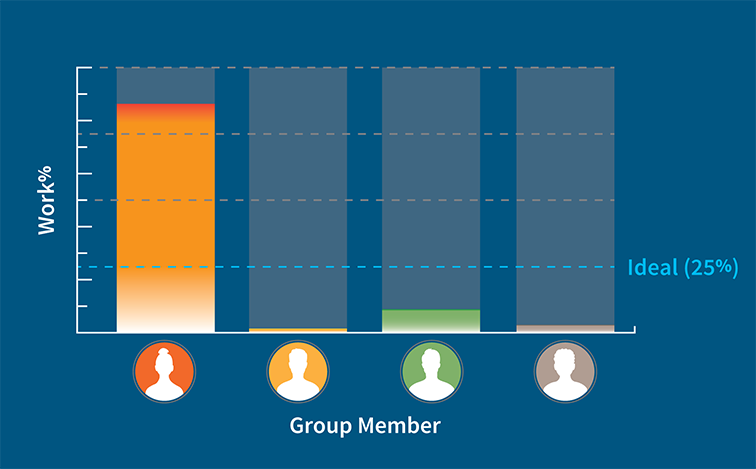Every month our team of Instructional Designers meets for “Talking Teaching” – sessions where we share and discuss interesting articles, methods, and pedagogies. This month, we discussed group work.
In this blog, I’d like to discuss the importance of group work for students, its common challenges (both in the classroom and online), and practical strategies to help alleviate problems and make group work more enjoyable and effective.
Best of all, these tips are applicable to all subject areas and don’t require any special software! Let’s learn how to teach students to work in groups.
The resources we’d like to share with you this month:
Seven Problems of Online Group Learning (and Their Solutions) is an open-access article published in the Journal of Educational Technology & Society (ET&S). This paper reviews published research on group work in the classroom, collates the most commonly-cited disadvantages of group work, and offers actionable steps to mitigate problems.
Demystifying Online Group Projects (Episode #403 from the Teaching in Higher Ed podcast, free to access through your preferred provider.) This conversation details the tips and tricks experienced educators have developed to smooth out common issues and make for more effective group work.
Group work grumbles
Problems with group work in the classroom
How do your students react when you assign a group project?
If they are like the majority of university students, group work in college can elicit strong responses – most of them negative. More often than not, learners prefer to work by themselves, citing the challenges of scheduling group meetings, differences in skills and abilities, and chiefly, the uneven distribution of work amongst group members.
If these complaints or problems with group projects in college sound familiar to you, fear not! We’ve put together a list of our favorite tips to help make for more effective group work in the classroom or online.
Group work strategies in the classroom
Acknowledge and celebrate soft skills
Group work goes against many students' preferred ways of learning. It is good to first acknowledge this and allow the students to express their concerns.
After this, try highlighting the benefits of small group work and how this can be applied to life after college or university. The purpose of group work isn’t just about specific content knowledge, but gaining valuable soft skills!

Some students would prefer to complete projects alone.
As Roberts and McInnerney (2007) point out, working in a group allows students to practice and hone their abilities to:
- negotiate how to work with a diverse group of people
- build rapport with other students
- communicate using a variety of strategies
- motivate their colleagues
- coordinate or lead group meetings – among many other skills.
These soft skills are often a focus of questions during job interviews, so group work experience can help prepare students with strong, concrete examples when seeking employment.
Additionally, individuals who excel in these collaborative skills are likely to find themselves in leadership and management positions where their role is to help a diverse group of people work together toward a common goal.
So, even if group work isn’t a learner's preferred way of completing a project, enlightening students as to these real-world benefits may make it more palatable!
Intentionally design student groups
Groups are typically formed in one of three ways:
- student choice
- random assignment, or
- intentional selection by an educator.
We loved the idea experienced educator Rebecca Houge shared (in episode 403 of the Teaching in Higher Ed podcast) about how she best sets students up for success.
Houge mentioned that one of the top challenges for students (especially taking online classes) is figuring out meeting times that suit everyone’s schedule.
This is especially true for students with diverse ages and backgrounds, who may have jobs, families, or other responsibilities that limit their availability.

The people in each group will have different responsibilities, and therefore different capacities.
To build the best groups, Rebecca sends out a simple student survey asking learners to state their:
- availability (morning/afternoon/evening, weekdays, weekends, etc.)
- communication preferences (email, text, etc.)
- perceived strengths and weaknesses (or areas they’d like to improve).
With this information, she can do her best to create groups that have compatible availability, and ideally, members who have varied strengths and weaknesses, to make for a more heterogeneous group that mimics real-life working scenarios.
Houge also provides some synchronous class time for students to meet (in virtual breakout rooms) to negotiate terms of their group work, and select a time to meet up.
While this approach does take more effort on the part of the educator, it eliminates some of the initial hurdles students have to navigate at the start of a group project. Intentionally-designed groups also set students up to reap the most benefits of group work by working with and learning from people with various strengths.
Be crystal clear with assessment
It’s no secret that grades are an enormous stressor for students. When you couple the pressure of attaining certain marks with having to rely on others to produce high-level work, the stress can be extreme!
Related: Learn 7 practical strategies to support student mental well-being »
The simple act of letting students know how their work will be graded at the very beginning of the group assignment can go a long way toward easing the worry that comes with grades.
A one-size-fits-all approach is not recommended. Students receive the greatest benefit when group work is assessed from multiple angles, including a score for a reflective self-assessment and peer assessment, in addition to the overall group project grade.
These aspects of assessment help students build metacognitive skills and improve their ability to provide constructive feedback, both of which are sought-after in the workplace.
Related: How to encourage metacognition »
Allowing students to have a grade separate from their peers provides learners with a greater sense of control (thereby lowering stress), and helps combat the common objection that group work isn’t fair, which leads us to our next strategy.
Redefine "fair"
Theoretically, if you have a group of four students, each one would complete 25% of the group work, right? Realistically, an even spread is rare – and this can be quite frustrating for students, especially those who are grade-conscious.
This uneven workload is so common that in the literature, students who do little work and ride on the coattails of other group mates are called “freeloaders” and those who end up doing all the work are “suckers”. (It should be noted that some students choose to be “suckers” because they feel like it’s easier to do the project alone.)

Sometimes, one student will end up taking on the bulk of the work in a project, leading to resentment.
It’s important to set the expectation that “fair” doesn’t always mean everyone completes equal work. This is mirrored in the real world, where work teams contribute toward projects at different paces and levels, due to a variety of factors.
Personal disposition (introversion or extraversion), mental or physical health, comfort or interest in the content topic and/or medium of group work, and personal responsibilities outside of the project are just a few variables that make group work harder or easier for some.
A group member who may appear to be “freeloading” could have a lot going on in their personal life (parenting responsibilities, caring for a sick loved one, juggling a job, etc.) and be giving the project all the effort they can muster. This is real life, and there is always a lot going on behind the scenes.
For these reasons, Rebecca Houge encourages her students to:
- assume good intentions of their peers (who may be enduring hardships they aren’t aware of), and
- focus on the benefits they personally are getting out of the work.
Educators can try to reframe perceived inequities as an opportunity for students to develop empathy for peers and gain experience modifying plans and redistributing work among other team members (while maintaining healthy boundaries).
Implementing self- and peer-assessment can also let students feel like they have a “voice” when the workload feels unfair.
Make projects big enough that they can't be completed alone!
If you’ve ever had a student mutter, “I could have done this better myself,” this strategy is for you!
To avoid this sentiment, try to design group projects so that they cannot be completed by one student alone.
For example, if your students are completing science lab group work using data acquisition, you may require each group member to record their own biological signals to show variations between people, and comment on trends.
If you’re doing a field experiment, group members could be responsible for canvassing different sites or sampling at different time periods to ensure all data are collected.
Depending on the content you’re working with, a more complex group project could take any form and require extra creativity on the part of the educator (...but if you’re taking the time to read a blog on how to improve group work, it’s likely you’re up for the challenge!).
On the topic of time, it’s important to remember that collaboration doesn’t happen quickly, so be sure to build in extra time to accommodate your students learning to work with one another.
In conclusion
Teaching group work skills to students may not be easy, but the benefits are huge.
With these practical strategies in your back pocket, we hope that you can turn down the volume on the typical group work grumbles, and amplify your students' willingness to work with each other and develop many lifelong practical skills.
Join the discussion
What do your students struggle with most in group projects? What strategies have you found that help students get the most out of group projects?
Join us in the ADI: Educator Community on LinkedIn and let other educators know your thoughts!
Our online community is a hub for life sciences education in #highered, where you can share resources, ask questions, get feedback, and build meaningful relationships - across campus and across the globe!
Related Talking Teaching articles:
Tired of teaching: What is teacher burnout and how can it be managed? »
Talking Teaching: Easing student anxiety with mindful study techniques »
Talking Teaching: Pedagogy of care and the role of faculty in student mental well-being »
How to format learning objectives to improve student learning »
